Review: Samsung Galaxy Note8
Sep 5, 2017, 10:00 AM by Eric M. Zeman
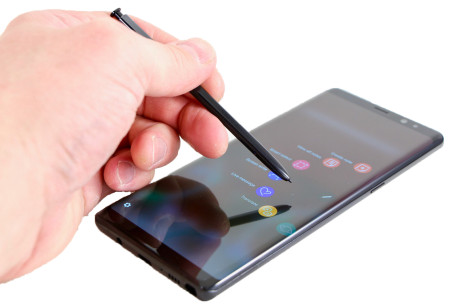
The Galaxy Note8 is Samsung's ultimate flagship for 2017. The Note8 takes the attractive design language from Samsung's own Galaxy S8 and pairs it with one of the largest screens and best cameras available. This Android powerhouse is more capable than most thanks to the added benefits of the S Pen stylus. If you want the biggest and the best, and have the huge amount of cash needed to buy this phone, then the Galaxy Note8 is indeed an attractive option. Here is Phone Scoop's in-depth review.
Is It Your Type?
The Galaxy Note8 is Samsung's strongest offering for professionals and others who require productivity on the run thanks to the powers of the S Pen stylus. The Note8 adopts the design language we saw on the S8 and S8+ earlier this year, and tweaks the size, shape, and feature set to appeal to a more work-minded base. The Note8 may be Samsung's most powerful smartphone, but that doesn't necessarily mean it's the best phone for everyone. It boils down to the two Ps: pen and photography.
Body
The Galaxy S8, announced in March, was a generational leap forward not only for Samsung, but for all phones. Many aspects of the S8's design signaled a new path that the rest of the industry will be forced to eventually follow in order to remain relevant. (LG has already done this, now we're waiting on Apple and others.) Samsung took the S8's design and adjusted it to accommodate the larger screen and S Pen stylus common to its Note-branded smartphones. The result is a blended beauty that stuns thanks to its sheer size and simplicity.
If we look back at the Note7, (pulled from the market due to disastrous battery fires,) we see the end of an era. It was the last major device from Samsung to debut before the company's radical re-imagining of its hardware with the S8 and S8+. Rather that follow its own path, the Note8 is more a retread of the S8+ with a few extra features added for good measure. What I'm trying to say here is that the Note8 is not as "new" as I'd like it to be, despite its gorgeous, refined design: it doesn't set the bar as high as it could have.
The Note8 is, at its most basic, a taller S8+ with sharper, more rectangular corners. The glass surfaces of the Note8 curve and flow into the metal frame seamlessly, making the Note 8 feel like a singular unit rather than an amalgamation of individual parts. The metal frame is visually indistinguishable from the glass around it on our black review unit thanks to a matching, shiny finish. The uniformity of the shape, the thin profile, the luscious materials all make the Note8 something to lust after, just like they (still) do with the S8 and S8+.
The Note8 carves the same oblong shape that defines its smaller siblings. The phone is narrow, yet very tall at 6.3 inches. It's significantly taller than the Pixel XL and iPhone 7 Plus. I do appreciate the Note8's narrow waist. What's it like to carry the phone around? The added height, thickness and weight make the Note8 more difficult to carry around at times. The height, it particular, got in the way when the Note8 was in my front pocket, making it more difficult to bend over to tie my shoes, for example, or sit in an airplane seat for hours. The sharper corners of the Note8 are more painful than the rounded shoulders of the S8+; they stab you through your pocket liners.
The Note8 was not designed to be a one-handed device, so don't kid yourself. It's more or less impossible to reach the top of the screen without performing some funky hand acrobatics. It's size definitely took me longer to adjust to than did the S8+'s size. The majority of Note8 owners, particularly those with smaller hands, will require two hands to operate this device at all times.
You'll be hard-pressed to find a more finely built handset than the Note8. Samsung selected high-quality Gorilla Glass and strong aluminum, and pieced them together flawlessly. The seams between metal and glass are practically nonexistent. Samsung has mastered the art of curved glass. The Galaxy Note8 is an expert vision in design, materials, and manufacturing.
The Note8 employs Samsung's Infinity Display concept, meaning the phone's face is nearly all screen. Samsung practically eliminated the side bezels entirely thanks to the curved glass. The bezels above and below the screen are more obvious than those of the S8+ thanks to the blockier corners. With no interruptions to the glass, the front face is left entirely smooth. The earpiece grille is almost invisible. Your eyes might find the user-facing camera and iris reader easily, but two sensors also located above the screen are nearly impossible to spot in the black glass. (All color options have a black front, to enhance the display design.) Samsung didn't even bother to cram its logo anywhere on the front face; that's how committed it is to the notion of the Infinity Display.
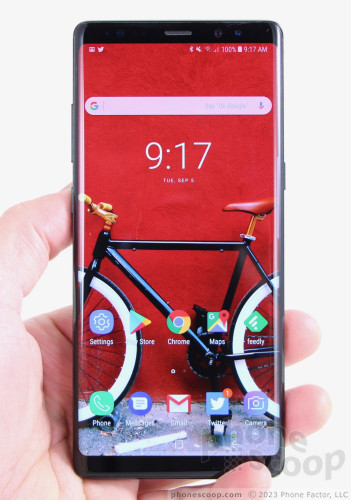
I love the way the slim metal frame wraps around the outer edges of the phone. The frame is only a couple of millimeters thick along the sides, but it swells up at the top and bottom. You may notice some plastic antenna lines, but they are color-matched fairly well.
Two buttons are located along the Note8's left edge. The top button is the volume toggle. It's only about an inch long, which makes it a bit too easy to accidentally press up when you mean to press down, and vice versa. The second button is dedicated to Samsung's Bixby personal assistant tool. I hate this arrangement (more on that later). The lock button is where you expect it to be, on the Note8's right edge. All of the side buttons have excellent profiles, and perfect travel and feedback. Samsung tucked the nano SIM and microSD memory card tray in the phone's top edge.
If you're upgrading from a Note5, it's time to adopt USB-C, which is the port found on the bottom of the Note8. This may require some new cables and/or accessories. Samsung also squeezed a standard 3.5mm headset jack and the speakerphone onto the Note8's bottom edge. The headphone jack is nice to have, considering some phone makers have dropped it.
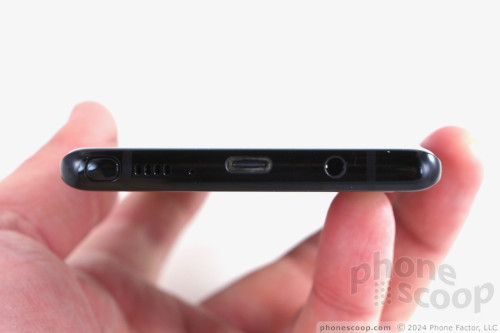
The S Pen is tucked into the bottom corner on the right side. You need to press the small, squarish top of the S Pen to pop it out. It slides in and out easily, and cannot mistakenly be inserted the wrong way. The stylus itself has a rectangular shape. The button is located in one of the wider sides. Samsung moved the button closer to the pen tip, which I appreciate, though the button's action is minimal at best. The phone vibrates when you replace or retrieve the S Pen, and it will warn you if you accidentally leave the stylus behind. I found the S Pen popped partially out on accident from time to time. Over the course of a week, I pulled the Note8 out of my pocket on several occasions and found the top of the pen sticking out. You might need to keep an eye on it.
Like the front, the Note8's rear panel is nearly all uninterrupted glass. It's prone to fingerprints. If you shun a case, you'll find yourself wiping oily grime off the back constantly. I'm glad Samsung was able to set the dual-camera module flush with the rear surface. It's contained within a frame that also houses the flash, heart rate monitor, and fingerprint reader.
Samsung put the fingerprint sensor in an awkward spot on S8 / S8+ and I had hoped it would reconsider for the Note8. It didn't. It can be hard to reach and tricky to find. Moreover, its proximity to the camera module more or less ensures you're going to get fingerprints all over the lens, impacting photo quality. The camera app regularly reminds you to wipe the lens clean. The Note8's sheer size makes the fingerprint reader even harder to find than on the smaller phones, though I've found a case helps quite a bit.
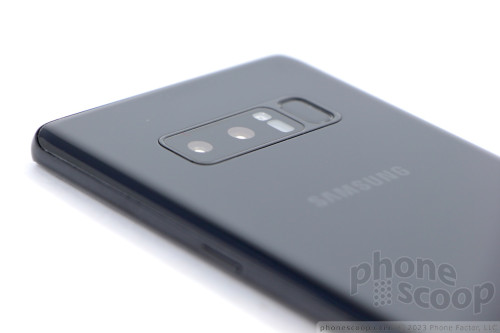
The Note8 is rated IP68 for protection against water, dust, dirt, and sand. Technically, it can sit in 1.5 meters (~5 feet) of water for up to 30 minutes without drowning. Moreover, the phone is waterproof with or without the stylus inserted, and the stylus works even when the screen is wet. I tested this, and found the Note8 survived water-based abuse just fine.
Durability is another matter. The phone may be protected by Gorilla Glass 5, but dual curved glass surfaces mean the phone is twice as likely to shatter when dropped. In fact, I dropped an S8+ earlier this year and the rear glass cracked. Not only does this look bad, it negates the water resistance. Using a case on a phone this expensive is an insurance policy you probably want to invest in.
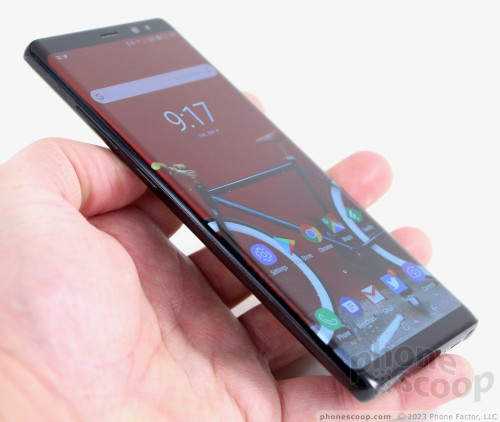
I don't like the Note8 hardware as much as I do the slightly smaller S8+, but you may feel differently. The S8+ is more usable in almost every way. That said, the Note8 is a fine, fine piece of hardware that's wholly impressive. For serious Note fans, there's no other phone to consider.
Screen
The Note8's display is visually arresting. Samsung has adopted a new aspect ratio for its flagship phones, which is an odd 18.5:9. It's nearly 2:1, but slightly taller. The screen measures 6.3 inches across the diagonal, with 2,960 by 1,440 pixels. (That's just 0.1 inches more than the S8+.) The aspect ratio makes it look tall and narrow, and it is. The Samsung-made Super AMOLED display supports mobile HDR video for incredible color range. As I said of the Note8's smaller siblings, the Infinity Display is infinitely appealing. I can't heap enough praise on it. The Note8 delivers razor-sharp text, images, and graphics; the resolution is second-to-none. The display is very bright and easy to use indoors and out. Samsung even managed to improve viewing angles and color a bit, compared to the S8 and S8+.
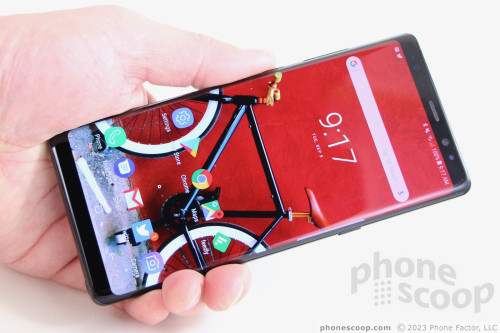
You can control the resolution. Samsung allows Note8 owners to choose between three resolutions: 1,480 by 720 pixels, 2,220 by 1080 pixels, and the display's full 2,960 by 1,440 pixels. Out of the box, the phone is set to the middle option, which Samsung calls Full HD+. The middle option is only slightly less amazing than the phone's full resolution. The benefit of choosing a lower resolution is better battery life. The full resolution (Quad HD+) is outstanding when it comes to virtual reality content.
The size, shape, and resolution of the Note8 also help with running two apps at the same time in split-screen mode.
You may notice that not all apps support the taller aspect ratio. You'll often see an alert at the bottom of the screen to "extend to full screen." Essentially, Samsung's software will stretch apps a bit further down the screen to cover all the pixels, while leaving its software-based controls visible at the same time. I suggest you take this path when it is presented.
Signal
I tested the Galaxy Note8 on AT&T's and T-Mobile's networks in and around New York City, as well as several German networks when roaming in Berlin. The phone delivers excellent wireless performance. The Note8 offers wide support for the major carriers' LTE bands, (though it is possible that carrier-branded models may not have all the bands enabled.) Notably, the Note8 supports T-Mobile's new Band 66 service, though not its newest Band 71 service (600 MHz).
The Note8 always remained connected to the network, whether the signal was strong or weak. The phone delivered blazing fast speeds, allowing me to upload photos and videos to Instagram no matter where I took it. Streaming music from Spotify and video from YouTube didn't present any challenges for the Note8. There were no hiccups. Facebook, Twitter, and email updates flew to/from the handset. Data never disappointed while I reviewed the phone.
The Note8 was able to connect all calls on the first dial. It maintained calls over long distances at highway speeds, and didn't drop any calls while I tested it. The cellular radio does its job well. This is what I expect from a flagship device.
Sound
The calls I made with the Note8 were above average when compared to other phones I've tested in recent months. The earpiece delivers clear, loud voices that have a pleasing tone. I didn't have any trouble hearing calls in noisy German train stations, nor in bustling airport hallways. I was impressed; you probably will be, too. People I spoke to through the phone said I sounded great.
The Note8 supports WiFi calling on both AT&T and T-Mobile. Setting this service up hardly takes more than a few seconds and delivers a small but noticeable upgrade to audio quality. If you can make calls over WiFi, you'll appreciate the improved clarity.
The speakerphone outperforms those in the S8 and S8+. During my tests I found I could keep the volume at about 60% for most spaces. You will need to turn it up in the car, but it doesn't suffer from as much distortion as Samsung's older flagships.
Ringers and alerts are loud enough to get your attention, and the vibrate function always made me take notice. I love that you can control vibration intensity and even select from a dozen or so different vibrating patterns.
I wish the phone had stereo speakers. Like the S8 and S8+, the Note8 ships with a pair of specially-tuned AKG earbuds. Believe it or not, they work pretty well. (I'm picky about audio; in-box earbuds usually disappoint.) They're nothing fancy, but the included software lets you tweak the sound enough that I would consider using the AKGs in a pinch, were my favorite Bluetooth headphones missing or uncharged.
Battery
We could talk about Samsung, the Note series, and batteries all day long. What you need to know is this: the 3,300 mAh battery in the Note8 may be smaller than the one in the S8+, but it lasts just as long (if not longer.)
Using a smartphone during a trade show (6-day work trip) is the ultimate battery test. I used the Note8 as my main device while reporting all over Berlin. The Note8 delivered the goods. After long days of incredibly intense use, the Note8 often had 50% battery life remaining well after midnight. Only once did it ever reach just 40%. I was roaming on a foreign network, using social networks, taking pictures, listening to music via Bluetooth, uploading videos, seeking directions and navigating, and much much more each day. The phone crushed it.
I will say this: I set the screen to the middle resolution (2,220 by 1080 pixels) and kept the screen on the automatic brightness setting during the majority of my review. At full resolution and set at 60% brightness, the screen took a greater toll on battery life and you might find it reaching 20% after an intense day of use. Even then, you have plenty to spare.
The Note8 includes three different power-saving modes from Samsung: off, mid, max. "Mid" reduces some behaviors and "max" really restrains the phone. Moreover, each mode can be customized to a certain degree (tweak brightness, CPU output, notifications, etc.) so you get exactly what you want/need out of them. You can also take control of individual apps to make sure they aren't draining power in the background.
The Note8 supports Quick Charge 3.0 and rapid wireless charging. When plugged into the included wired charger, I found the Note8 charged from 40% to 100% in 75 minutes. Wireless charging took only a little longer using Samsung's rapid wireless charging pad. It feels quick either way, and a short 15-minute charge pushes about 30% into the battery. It will even charge through most cases.
Bluetooth, GPS, NFC, WiFi
The Note8 includes Bluetooth 5.0. This doesn't mean a whole lot right now, but it ensures the phone will be compatible with some high-performance Bluetooth 5.0 accessories down the road. The Note8 worked with all of the Bluetooth devices I pushed at it, including phones, cameras, headsets, speakers, and PCs. The Note8's Bluetooth software made pairing with a variety of devices a simple, painless process. I didn't encounter any trouble with it. Calls sent to mono headsets sounded very good, while calls routed to my car's hands-free system were improved compared to the S8/S8+. Music pushed to a stereo speaker sounded excellent.
Of course the Note8 includes GPS and it worked perfectly with Google Maps and other apps. Maps was able to pinpoint me in several blinks of an eye, and location was as good as 10 feet. The Note8 makes for a fine navigation device via Maps, Waze, or the voice-guided app of your choice.
The Note8 ships with Samsung Pay, which is one of many apps that can take advantage of the NFC radio. NFC is also compatible with Android Pay. I mostly used the NFC radio to assist in pairing with Bluetooth accessories. To that end, it worked perfectly. Samsung Pay also works with MST (magnetic strip), which is available within the Note8 too.
Last, the Galaxy Note8 packs 802.11a/ac/b/g/n/ac dual-band WiFi. This means the Note8 is compatible with a wide range of WiFi access points for the best speeds. I had no trouble at all with the Note8's WiFi.
Comments
Does the unlocked Note 8 support VoLTE on AT&T, T-Mobile & Verizon?
Does the unlocked Note 8 support VoLTE on the 3 real phone networks (AT&T, T-Mobile & Verizon)?
I ordered an unlocked Note 8, but may return it if there is no VoLTE support.
Thanks to all!


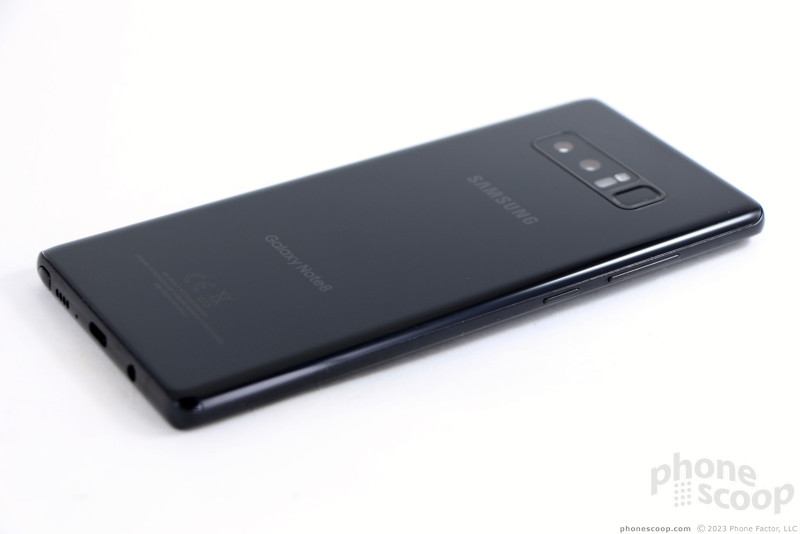













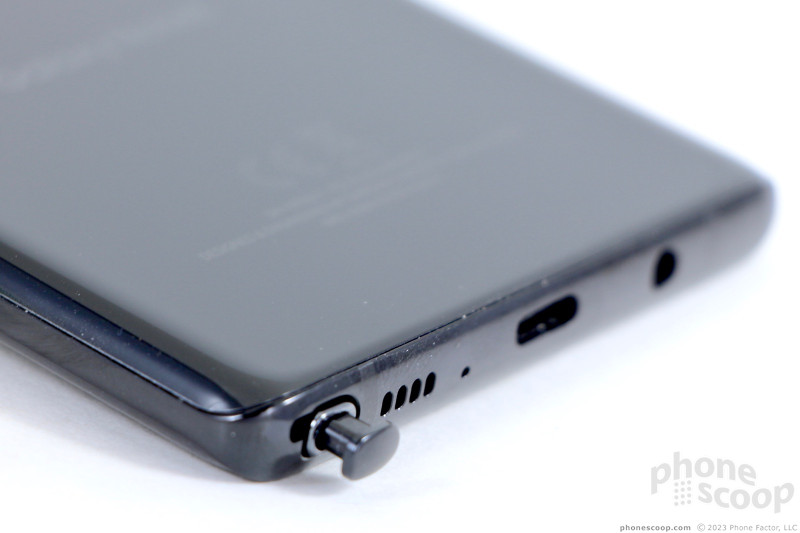






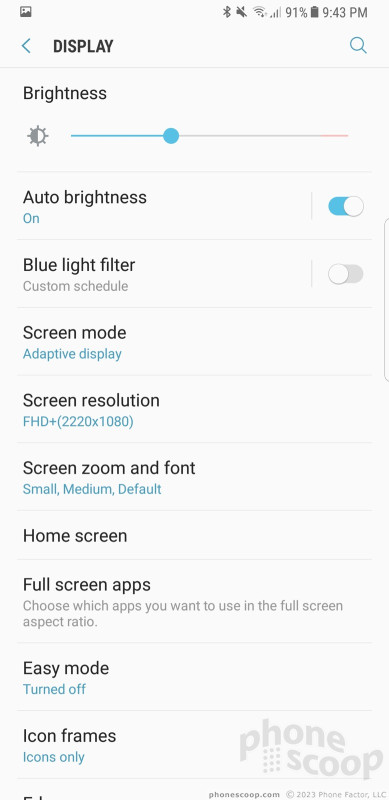



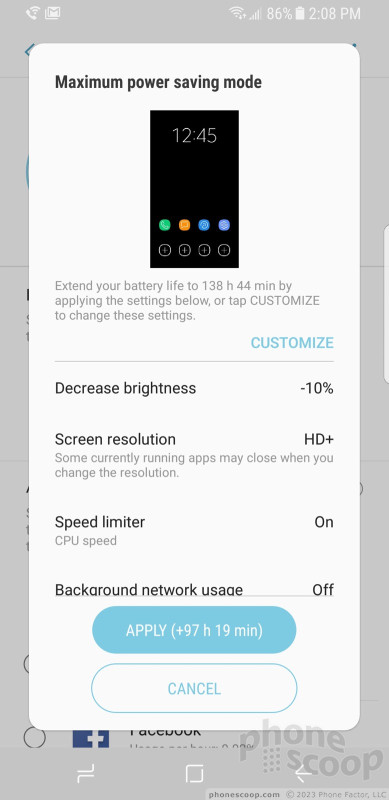





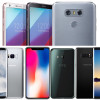 Top Five Flagship Handsets of 2017
Top Five Flagship Handsets of 2017
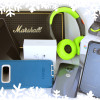 Holiday Gift Guide 2017
Holiday Gift Guide 2017
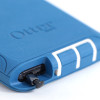 Review: Otterbox Cases for Samsung Galaxy Note8
Review: Otterbox Cases for Samsung Galaxy Note8
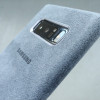 Review: Samsung Alcantara Case for Galaxy Note8
Review: Samsung Alcantara Case for Galaxy Note8
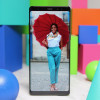 Hands On with the Samsung Galaxy Note8
Hands On with the Samsung Galaxy Note8
 Samsung Galaxy Note8
Samsung Galaxy Note8



